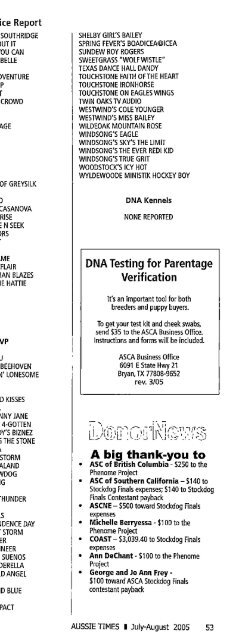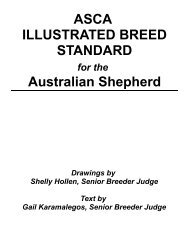Create successful ePaper yourself
Turn your PDF publications into a flip-book with our unique Google optimized e-Paper software.
In Other Words<br />
The Bobtail Trait<br />
in Australian Shepherds<br />
Gemi Sasson-Brickson, M.S. Biology • Enon, Ohio<br />
Part III:<br />
Objectives of the Ongoing Study<br />
(This is the last of a three-part series on the<br />
bobtail trait in Australian Shepherds, written<br />
in relation to my study on the inheritance of<br />
the natural bobtail trait [NBT)[ in Australian<br />
Shepherds. This article addresses the<br />
ongoing study of the inheritance of the NBT<br />
in Australian Shepherds, its objectives and<br />
information relating to study participation, as<br />
well as some preliminaryfindings ofthe study.<br />
Previous articles covered international laws<br />
and regulations and information on genetics<br />
Why<br />
and health.)<br />
is it important to<br />
understand how the natural<br />
bobtail trait is inherited in<br />
our breed and what effect it<br />
might have on neonatal health, if any? In<br />
the initial article of this series, I discussed<br />
the docking bans in various countries. This<br />
movement was initiated by the enactment of<br />
the European Convention for the Protection<br />
ofPetAnimals, which went into effect in the<br />
early 1990s. Inarguably, the main premise<br />
behind these laws is a tenet that docking<br />
violates the moral obligation, and thus the<br />
role as guardian that humans have toward<br />
their animals. Paragraph lib of the German<br />
Animal Protection Act basically states that<br />
it is forbidden to breed animals or change<br />
them through either biological or genetic<br />
measures so that their body parts (organs,<br />
skeletal structure, etc.) will be altered to a<br />
degree that such alteration may inflict pain,<br />
suffering, or damage. Depending on the<br />
evidence available, this could be interpreted<br />
in varying ways. To date, the German law<br />
has mostly been applied to the breeding of<br />
excessively aggressive animals. Already,<br />
there have been a few cases of registries<br />
placing restrictions on the breeding of<br />
two naturally bobtailed parents together,<br />
perhaps due to some of the myths that<br />
were addressed in the second article ofthis<br />
seriesregardinghealth and genetics.Before<br />
we allow such restrictions to creep further<br />
106 AUSSIE TIMES I <strong>July</strong>-<strong>Aug</strong>ust <strong>2005</strong><br />
into various registries, it is imperative to<br />
study whether or not these precautionary<br />
measures are warranted. That is one of the<br />
things this study attempts to do.<br />
• In the United States, where docking<br />
is routinely performed on Aussie litters,<br />
whether or not a dog is NBT is normally<br />
not a factor when deciding which dogs to<br />
continue with. Although a few decades<br />
ago more emphasis was probably placed<br />
upon retaining the NBT, today American<br />
breeders are looking at many other things<br />
like structure, perceived breed type,<br />
situation-specific working traits, and<br />
performance potential, and health issues<br />
such as juvenile cataracts, epilepsy, and<br />
hip dysplasia.<br />
A<br />
natural bobtail is<br />
actuaiiy a beneficiai<br />
feature for a dog<br />
gathering iivestock<br />
out of the brush.<br />
In Europe now, some breeders are<br />
selecting away from the NBT, whether<br />
through individual preference or demands<br />
from buyers for a full tail, or due to<br />
restraints in breeding options. Conversely,<br />
other European breeders have opted to try<br />
to preserve the NBT whenever possible as<br />
the identifying characteristic within the<br />
breed that it is. After all, a natural bobtail<br />
is actually a beneficial feature for a dog<br />
gathering livestock out of the brush in that<br />
there is no extra hair there to mat or collect<br />
burs. With a considerable percentage of<br />
the breed possessing the NBT trait, either<br />
breeding toward or away from NBTs has<br />
the possibility of having a definite impact<br />
on which individuals are retained within<br />
the gene pool and, consequently, the<br />
other traits that they will pass on to their<br />
offspring. This selective pressure poses<br />
the potential for what's called "genetic<br />
drift'". Maintaining genetic diversity<br />
does provide for more variability in any<br />
species—and this can be both a good or bad<br />
thing. Selectiveness gives us uniformity.<br />
Variety gives us options. Both have their<br />
price. The more selective a breeder is about<br />
pulling in or weeding out a certain trait, the<br />
more alike the products of their breeding<br />
will be. But doing so will also further<br />
concentrate other traits, good and bad, as<br />
it is not within anyone's power to sort out<br />
genes from each other as if one were mixing<br />
ingredients in a recipe. As someone who<br />
purchased their first Aussie nearly 20 years<br />
ago, I have seen the predominant concerns<br />
about the breed shift and alter through the<br />
years. While certain concerns such as poor<br />
temperament or debilitating health defects<br />
certainly merit the utmost regard, breeders<br />
must always keep in mind the complexity<br />
of genetics and just how many possible<br />
gene combinations we are dealing with<br />
when we cross two individuals and get ten<br />
puppies. I mention this because of those<br />
European breeders who have reported that<br />
many of their requests are for full-tailed<br />
puppies. I find this a sad situation because<br />
there are and have been so many bobtailed<br />
Aussies who have contributed positively<br />
to our breed. Do I think, therefore, that we<br />
should start concentrating on getting more<br />
NBTs so we don't lose that trait? Certainly<br />
not. WhatI am saying is that we should look<br />
at the complete picture, full-tail, half-tail,<br />
or no tail, when choosing future breeding<br />
prospects.<br />
So what does it matter if NBT x<br />
NBT breedings are not allowed in certain<br />
countries? Or even if breeders just choose<br />
not to do them? What happens is that a<br />
breeder's optionsare reduced.If the bobtail<br />
trait in Aussies is indeed a dominant one,<br />
as it is in Pembroke Welsh Corgis, that<br />
means that a fairly large number of our<br />
dogs are genetically NBTs. If one can't<br />
or chooses not to cross two NBTs, what<br />
might have been the best overall choice



